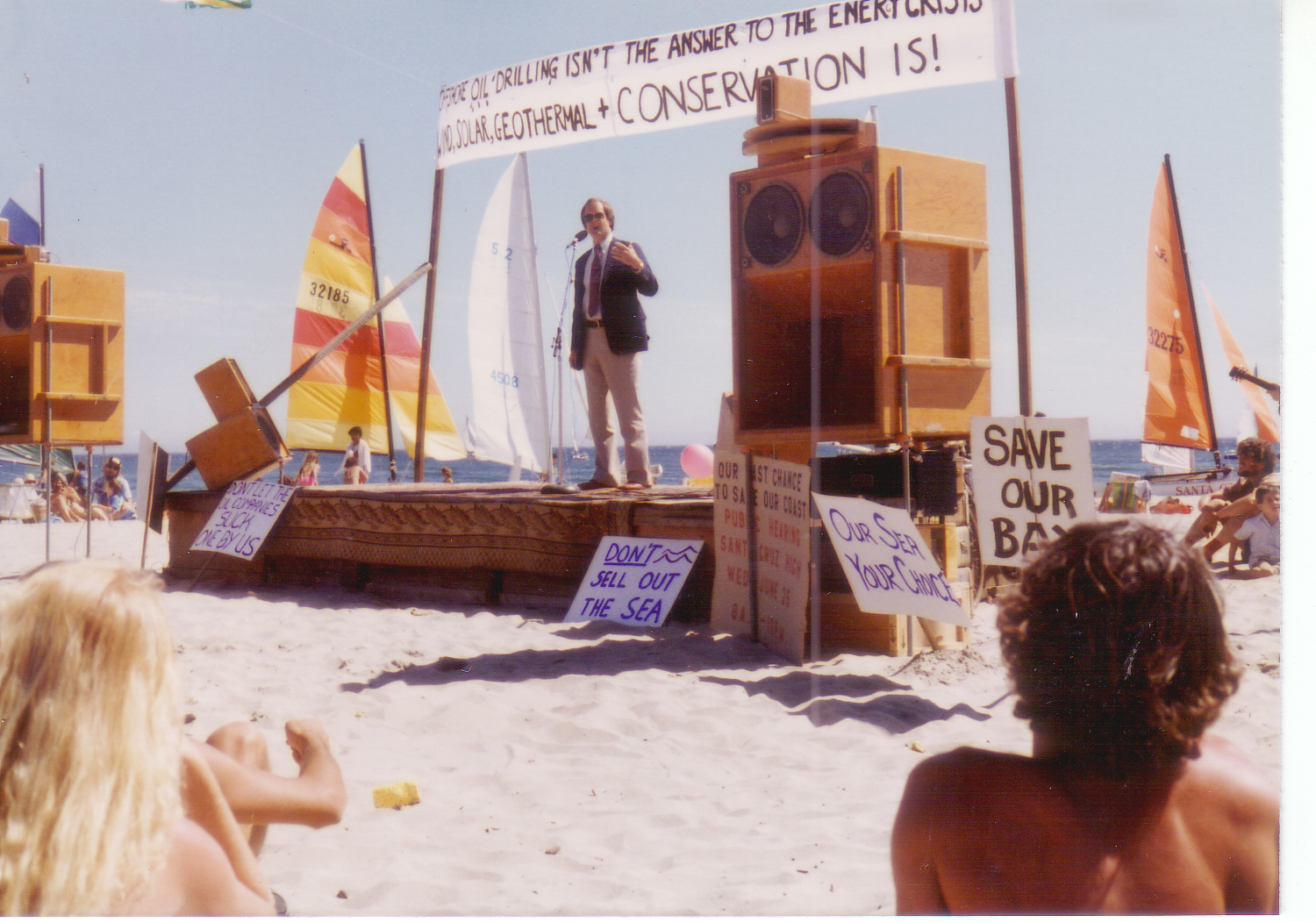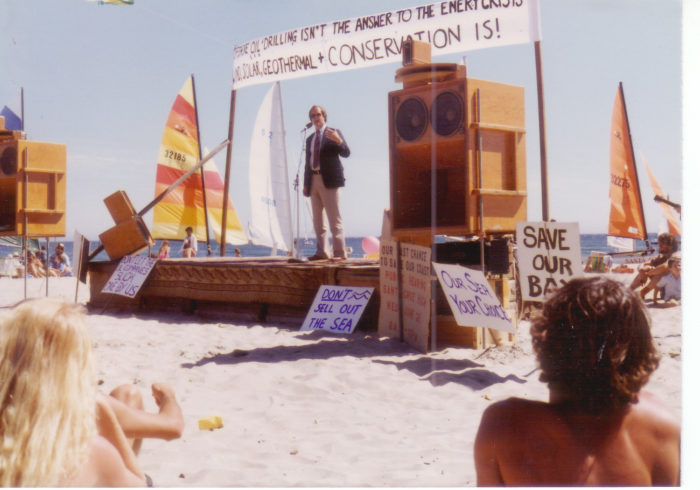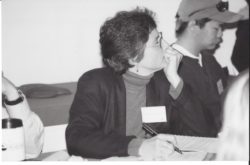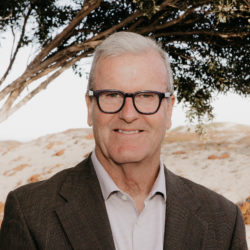
Sanctuary 30th Anniversary Series – Blog #2 “Finding sanctuary: Many hands helped to stop drilling threat” by Dan Haifley

Then-Monterey County Supervisor Sam Farr at Save Our Shores rally in Santa Cruz in 1978. (Kim Tschantz/Contributed)
PUBLISHED: Santa Cruz Sentinel, July 10, 2022
PUBLISHED: Monterey Herald, July 16, 2022
People across the political spectrum had fought since the late 1970s against the threat of offshore “lease sales” that had been scheduled for federal waters off southern, central, and northern California. Lease sales are auctions of individual nine square mile tracts of the sea floor in federal waters, 3 miles to 200 miles offshore, by a bureau of the U.S. Department of Interior to oil companies for drilling.
A tradition of activism
In the Monterey Bay region, decades of activism had, among other things, resulted in the defeat of a proposed nuclear plant near Davenport, and successful opposition to a deep-water oil port at Moss Landing. In 1972, California voters had approved Proposition 20 — the California Coastal Act — which established the Coastal Commission and made beach access a state goal. That same year, with the terrible televised images of the 1969 Santa Barbara oil spill fresh in their constituent’s minds, Congress approved a raft of environmental laws, including one that established national marine sanctuaries.

Rachel Saunders, who was co-chair of the Environmental Working Group. (Save Our Shores/Contributed)
Save Our Shores was formed in 1978 by volunteers Kim Tschantz, who was elected chair, Carol Mountz, Joan Harrington, Karen Delaney, Nelson Wolf, John Murray, Bonnie and Gordon Schmeisser, Kay Smothers and Van Tunstall as the public learned of a proposal – Lease Sale 53 — to drill for oil in federal waters off central California. The public, organized by SOS and other organizations including chambers of commerce, responded with opposition rallies, petitions, letters and attendance at public meetings, and as a result, the plan was withdrawn by President Jimmy Carter.
Carter was defeated in the 1980 election by Ronald Reagan, who had two Secretaries of Interior during his eight years in office, James Watt and Donald Hodel, who renewed the push for offshore oil in California and beyond. Their proposals to sell off tracts of ocean floor to the oil companies over that time met with so much resistance that they became a contentious issue in California and other coastal states in the 1988 presidential election.
From fighting oil to finding sanctuary
After his own election to Congress in 1976, Leon Panetta began to lead the fight in Congress against offshore oil. He worked with the House Appropriations Committee to obtain an annual freeze on federal funds needed to plan for offshore leasing. He was backed by the work of Richard Charter, a Bodega Bay resident who lobbied members of Congress and ran a grassroots network of local governments organized by then-Santa Cruz County Supervisor Gary Patton and environmentalists who could turn out letters and phone calls to members of the House Appropriations Committee in large numbers. The Association of Monterey Bay Area Governments, a local government coalition formed to fight ocean sewage disposal from inland areas, developed a slideshow to fight drilling, and initiated a unique effort to engage tourists to write their own members of Congress to protect the ocean.
In 1988, Panetta secured congressional authorization for the National Oceanic and Atmospheric Administration to begin the planning for a marine sanctuary at Monterey Bay, a story he will tell in a future column. This provided an opportunity for permanent protection for areas that were vulnerable to oil drilling, such as the coastline between Santa Cruz and San Francisco. To make this happen, a coalition of organizations formed the Environmental Working Group to promote the largest boundary and strongest protections. Representing Save Our Shores, I was co-chair, along with Rachel Saunders of the Center for Marine Conservation, now called the Ocean Conservancy. Other organizations included the League of Women Voters, Sierra Club, Coastal Advocates, Friends of the Sea Otter, Defenders of Wildlife, the Monterey Dunes Coalition, and the Surfrider Foundation’s Santa Cruz Chapter.
Also participating was long-time environmentalist and respected Pacific Grove resident Jo Stallard, who also served on a committee formed by Panetta and his wife and unpaid adviser, Sylvia Panetta, to help guide discussions about the proposed Sanctuary. That group also included Monterey County Agricultural Commissioner Dick Nutter, fisherman Dave Danbom, State Assemblymember Sam Farr, State Sen. Henry Mello, Santa Cruz County Supervisor Robley Levy, and Monterey County supervisors Karin Strasser-Kauffmann and Marc Del Piero, and representatives for tourism, science and environmental institutions, and chambers of commerce. Mello was an advocate for the largest possible boundary for the sanctuary, a nod to his long history opposing offshore oil that pre-dated the Santa Barbara oil spill. In 1967, he led the Santa Cruz County Board of Supervisors in opposition of a permit to allow oil testing near Año Nuevo Island.
The National Oceanic and Atmospheric Administration’s marine sanctuaries office developed seven options for its boundaries and size. The Environmental Working Group supported “Option Five” to protect an area stretching from Cambria in San Luis Obispo County to Point Reyes in Marin County. The key was to protect waters between Santa Cruz and San Francisco, a target for drilling.
In Sacramento, Assemblymember Jacqueline Speier of San Mateo successfully carried a bill to put the legislature on record in support that largest boundary option, while the Port of Oakland, which was deepening its port and shipping lane, told members of the legislature that it wanted to continue disposing dredge spoils offshore San Francisco. The final plan allowed it until its useful life was complete. In my next installment: oil spills, intertidal creatures near Half Moon Bay, and presidential election politics fuel the drive for permanent protection.

Dan Haifley currently serves on the Monterey Bay National Marine Sanctuary Foundation board. He was director of Save Our Shores 1986-1993, and O’Neill Sea Odyssey from 1999-2019. He can be reached at dan.haifley@gmail.com. For more on the sanctuary’s 30th anniversary, go to montereybayfoundation.org.
About this series
Monterey Bay National Marine Sanctuary celebrates its 30th anniversary this fall, and the national sanctuary system celebrates its 50th. For the next 12 weeks, the Sentinel will publish columns by former U.S. Secretary of Defense Leon Panetta, along with Sam Farr, Dan Haifley, Fred Keeley, and Sanctuary Superintendent Dr. Lisa Wooninck. All of these contributors serve on the board of Monterey Bay National Marine Sanctuary Foundation and were involved with the Sanctuary’s designation.
